In 2D materials and their heterostructures, many experimental knobs, such as carrier density, electrical displacement, pressure, etc., can be tuned to explore and control their properties. One controllable knob is the twisted angle, leading to the concept of twistronics. By tuning the twisted angle between two van der Waals layers, one can tune the strength of interlayer coupling and the hybridization of band structure, thus significantly modifying their electronic properties.
Taking graphene for instance, the physical pictures are totally different in various angle regime: at twisted angle around or larger than 2°, the band spectrum consists of two uncoupled Dirac cone; near magic angle (~1.1°), strong interlayer hybridization results in a flat band and strong correlations emerge; at marginally twisted angle below 1°, atomic lattice reconstruction leads to the formation of topological one-dimensional conducting channel.
How twisted angles affect other 2D materials is still under exploration. We are trying to contribute to this emerging field.

References:
1. S. G. Xu, et. al., “Giant oscillations in a triangular network of one-dimensional states in marginally twisted graphene”, Nature Communications, 10, 4008, (2019).
2. A. I. Berdyugin, B. Tsim, P. Kumaravadivel, S. G. Xu, et. al., “Minibands in twisted bilayer graphene probed by magnetic focusing”, Science Advances, 6, 16, eaay7838, (2020).
3. S.G. Xu, et. al., “Tunable van Hove singularities and correlated states in twisted monolayer-bilayer graphene”, Nature Physics, https://doi.org/10.1038/s41567-021-01172-9, (2021).
|